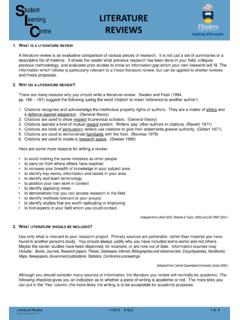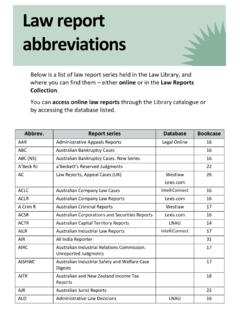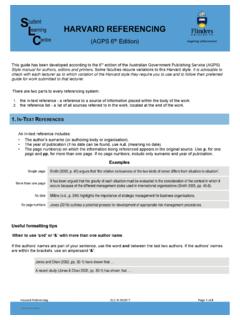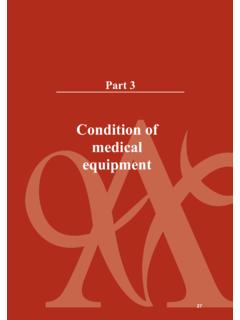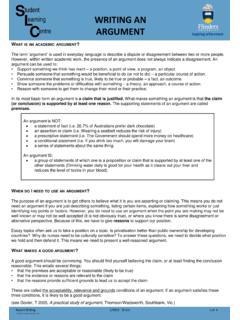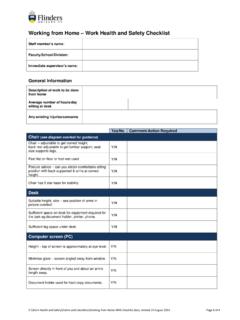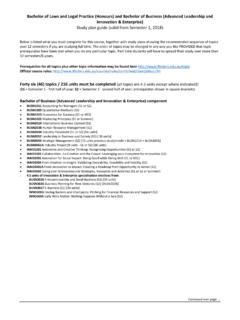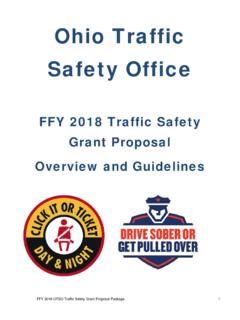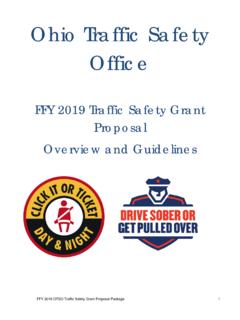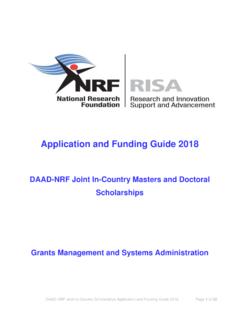Transcription of APA Referencing (1) - Flinders University
1 APA Referencing (American Psychological Association)tudentCearningLSentreThis leaflet is intended as an introductory guide to the use of APA Referencing system. For more detailed information refer to the Publication Manual of the American Psychological Association(6thedn, 2010). Before you commence your assignment you should check with your topic course book for the bibliographical style required in that topic. Referencing is a standard convention within the academic and professional communities designed to inform readers of the sources of information used in a piece of written work. There are a number of Referencing formats in common use, with certain styles preferred in different academic departments. The APA system is that which is most commonly used in the Social Sciences. You are expected to cite all your references in order to: acknowledgeyour sources allow the reader to verify the data / information allow the reader to consult your sources independently showthe reader the depth and breadth of your importantly, the reader knows how your thinking and reasoning has been formed based on the material you have read.
2 In other words, the reader knows where you are coming from .References must be provided wherever you quote (use exact words), paraphrase (use other people's ideas using your own words), summarise(use main points of someone else's opinions, theories or data) or useother people s data or figures. Your references may be sources of information such as books, periodicals, web sites, newspapers, government reports, legal cases, electronic recordings (CD, DVD, television) or APA system of Referencing consists basically of two components:1)In-text Citation: This is the in-text reference to the source of the information. For example, within your assignment, you could write: 2)The Reference List: The is a list at the end of the written text of all references cited. Using the example above, at the end of the assignment you would have: APA Referencing1/2015 SLC 1 of 6 Rumbaugh (1995) reported that "Kanzi's comprehension of over 600 novel sentences of request was very comparable to Alia's; both complied with requests without assistance on approximately 70% of the sentences" (p.
3 722).Rumbaugh, D. (1995). Primate language and cognition: Common ground. Social Research, 62, Referencing1/2015 SLC 2 of 61) IN-TEXTCITATIONThe APA's in-text citations provide at least the author's family name and the date of publication. For direct quotations and some paraphrases, a page number is given as well. A page number is not required for a summary or a paraphrase, but include one if it would help readers find the passage in a long work. The following models illustrate the APA style of in-text citation. NOTE: In the models in this section, notice that APA style requires the use of the past tense or the present perfect tense in signal phrases introducing cited material: Smith reported, Smith has may not always be the case in your own writing as different departments have different format for a , introduce the quotation with a signal phrase that includes the author's family name followed by the date of publication in parentheses. Put the page number (preceded by "p.
4 ") in parentheses after the (1996) wrote that some primatologists "wondered if apes had learned Language, with a capital L" (p. 109).If the signal phrase does not name the author, place the author's family name, the year, and the page number in parentheses after the quotation. Use commas between items in the parentheses:(Hart, 1996, p. 109).Basic formatfor a summary ora paraphraseInclude the author's family name and the date either in a signal phrase introducing the material or in parentheses following to Hart (1996), researchers took Terrace's conclusions seriously, and funding for language experiments soon took Terrace's conclusions seriously, and funding for language experiments soon declined (Hart, 1996). A work with two authorsName both authors in the signal phrase or parentheses each time you cite the work. In the parentheses, use "&" between the authors' names; in the signal phrase, use "and".Greenfield and Savage-Rumbaugh (1990) have acknowledged 's linguistic development was slower than that of a human child (Greenfield & Savage-Rumbaugh, 1990, p.
5 567).A work with three to five authorsIdentify all authors in the signal phrase or parentheses the first time you cite the source. The chimpanzee Nim was raised by researchers who trained him in American Sign Language by moulding and guiding his hands (Terrace, Petitto, Sanders, & Bever, 1979).In subsequent citations, use the first author's name followed by "et al." in either the signal phrase or the was able to string together as many as 16 signs, but their order appeared quite random (Terrace et al., 1979).A work with six or more authorsUse only the first author's name followed by "et al." in the signal phrase or the ape language studies have shed light on the language development of children with linguistic handicaps (Savage-Rumbaugh et al., 1993).Organisation as authorIf the author is a government agency or other corporate organisation, name the organisation in the signal phrase or in the parenthetical to the Language Research Centre (2000), linguistic research with apes has led to new methods of treating humans with learning disabilities such as autism and the organisation has a familiar abbreviation, you may include it in brackets the first time you cite the source (National Health and Medical Research Council, 2001) and use the abbreviation alone in later citations (NHMRC, 2001).
6 Two or more works in the same parenthesesWhen your parenthetical citation names two or more works, put them in the same order that they appear in the reference list ( alphabetically), separated by argued that the apes in the early language experiments were merely responding to cues (Sebeok & Umiker-Sebeok, 1979; Terrace, 1979).APA Referencing1/2015 SLC 3 of 6 Personal communicationInterviews, letters, e-mail, and other person-to-person communications should be cited as follows:One of Patterson's former aides, who worked with the gorilla Michael, believes that he was capable of joking and lying in sign language (E. Robbins, personal communication, January 4, 2000).Note: personal communication is not included in the reference electronic documentWhen possible, cite an electronic document as you would any other document (using the APA style)Fouts and Fouts (1999) have explained one benefit of ape language research. It has shown us how to teach children with linguistic sources may lack authors' names or dates.
7 In addition, they may lack page numbers (required in some citations). Here are APA's guidelines for handling sources without authors' names, dates, or page author / AnonymousIf the author is unknown, mention the work's title in the signal phrase or give the first word or two of the title in the parenthetical citation. Titles of articles and chapters are put in double quotation marks; titles of books and reports are in separate areas of Africa differ in a range of behaviors. An international team of researchers has concluded that many of the differing behaviors are cultural, not just responses to varying environmental factors ("Chimps," 1999).In the rare case when "Anonymous" is specified as the author, treat it as if it were a real name: (Anonymous, 2001). In the list of references, also use the name Anonymous as dateWhen the date is unknown, APA recommends using the abbreviation " " (for "no date"). Attempts to return sign-language-using apes to the wild have had mixed results (Smith, ).
8 No page numbersAPA ordinarily requires page numbers for direct quotations, and it recommends them for long summaries or paraphrases. When an electronic source lacks stable numbered pages, your citation should include (if possible) information that will help readers locate the particular passage being cited. When an electronic document has numbered paragraphs, use the paragraph number preceded by the symbol or by the abbreviation "para.": (Hall, 2001, 5) or (Hall, 2001, para. 5). If neither a page nor a paragraph number is given and the document contains headings, cite the appropriate heading and indicate which paragraph under that heading you are referring to:According to Kirby (1999), some critics have accused activists in the Great Ape Project of "exaggerating the supposed similarities of the apes [to humans] to stop their use in experiments" (Shared Path section, para. 6).Electronic files using portable document format (PDF) often have stable page numbers. For such sources, give the page number in the parenthetical sourcesIf you use a source that was cited in another source (a secondary source), name the original source in your signal phrase.
9 List the secondary source in your reference list and include it in your parenthetical citation, preceded by the words "as cited in". In the following example, Booth is the secondary source ( the source that you have direct access to):Linguist Noam Chomsky has dismissed the studies on Kanzi with a flippant analogy: "To maintain that Kanzi has language ability is like saying a man can fly because he can jump in the air" (as cited in Booth, 1990, p. A3).Two or more works by the same author in the same yearWhen your list of references includes more than one work by the same author in the same year, use lowercase letters ("a", "b" and so on) with the year to order the entries in the reference list. Use those same letters with the year in the citation:Research by Kennedy (2000b) has yielded new findings Referencing1/2015 SLC 4 of 62) THEREFERENCELISTIn APA style, the alphabetical list of works cited, which appears at the end of the paper, is titled "References . Every work cited in the text must be listed.
10 Each entry usually contains four main elements: author(s), year of publication, title, and publishing data, in this order. The publishing data for a book or monograph consists of the location and name of the publishing company, for a journal article it consists of the volume and issue numbers, page numbers, and Digital Object Identifiers (DOI) or Uniform Resource Locator (URL) if all details: capitalisation, punctuation, use of italics, and so on. Keep the list in alphabetical order by authors'family names; if a work has no author, alphabetise it by its title. The first element of each entry is important because citations in the text of the paper refer to it and readers will be looking for it in the alphabetised list. The date of publication appears immediately after the first element of the entry. Note: these examples only show the first two items of each reference (author name and date). There are a number of other important parts to be included, which are shown in the examples on the following author Conran, G.
